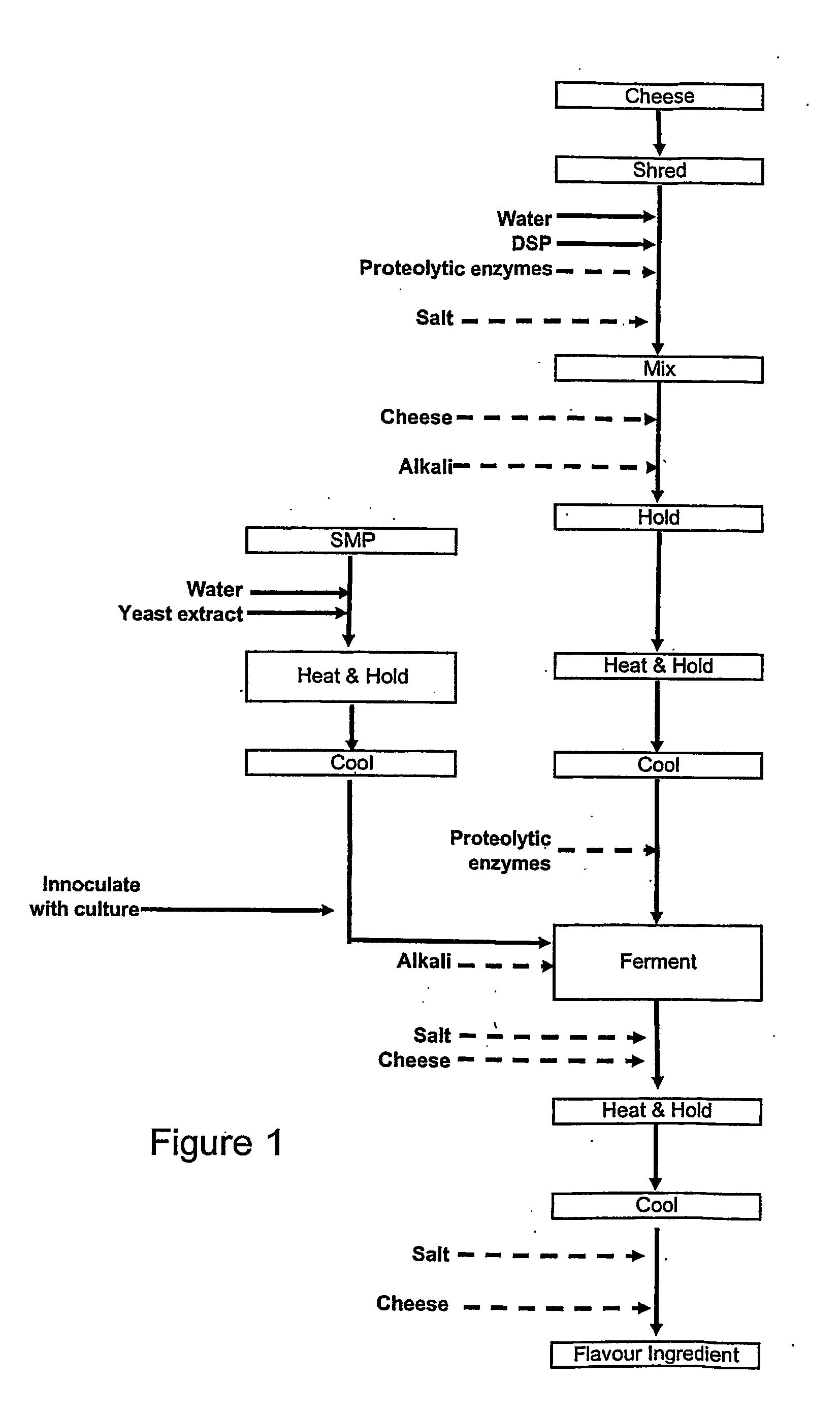Cheese flavour ingredient and method of its production
- Summary
- Abstract
- Description
- Claims
- Application Information
AI Technical Summary
Benefits of technology
Problems solved by technology
Method used
Image
Examples
example 1
[0084] A protein in water mixture comprising a cheddar cheese was formed and then incubated with protease enzymes in a first incubation and then incubated with protease enzymes and a culture of Enterococcus faecium B9642 in a second incubation.
[0085] Ingredients for the first incubation: 500 kg of grated commercial New Zealand Cheddar cheese; 12 kg of food grade disodium phosphate dissolved in 50 L hot water; 600 g proteolytic enzymes (protease A “Amano” and Neutrase in equal amounts) dissolved in 10 L water at 43° C.; 250 L water at 43 to 45° C.; 50% (w / w) solution of food grade NaOH.
[0086] Ingredients for the second incubation: 400 kg grated Cheddar cheese; 600 g proteolytic enzymes (protease A “Amano” and Neutrase in equal amounts) dissolved in 5 L sterile water; 26 kg of Enterococcus faecium B9642 culture; 50% (w / w) solution of food grade NaOH; 19.5 kg cheese salt.
First Incubation:
[0087] 1. The water was placed in a tank at a temperature of about 53° C. so addition of the c...
example 2
[0093] A protein in water mixture comprising a Gouda cheese source was formed in a first incubation then incubated with protease enzymes and a culture of Enterococcus faecium B9642 in a second incubation.
[0094] Ingredients for the first incubation: 440 kg of grated brine salted commercial New Zealand Gouda cheese; 10.5 kg disodium phosphate dissolved in 75 L hot water; 3 kg of cheese salt; 325 L water at 43 to 45° C.; 50% (w / w) solution of NaOH.
[0095] Ingredients for the second incubation; 760 kg grated Cheddar cheese; 1320 g proteolytic enzymes (protease A “Amano” and Neutrase in equal amounts) dissolved in 5 L sterile water; 26 kg of B9642 culture; 50% (w / w) solution of NaOH; 37 kg cheese salt.
First Incubation
[0096] 1. The water was placed in a tank at about 53° C. so the cold cheese would bring it down to about 43° C. The dissolved disodium phosphate was added with stirring following by approximately half the grated cheese over about 15 to 20 minutes. The mixture was stirred...
PUM
| Property | Measurement | Unit |
|---|---|---|
| Temperature | aaaaa | aaaaa |
| Temperature | aaaaa | aaaaa |
| Temperature | aaaaa | aaaaa |
Abstract
Description
Claims
Application Information
 Login to View More
Login to View More - R&D
- Intellectual Property
- Life Sciences
- Materials
- Tech Scout
- Unparalleled Data Quality
- Higher Quality Content
- 60% Fewer Hallucinations
Browse by: Latest US Patents, China's latest patents, Technical Efficacy Thesaurus, Application Domain, Technology Topic, Popular Technical Reports.
© 2025 PatSnap. All rights reserved.Legal|Privacy policy|Modern Slavery Act Transparency Statement|Sitemap|About US| Contact US: help@patsnap.com

